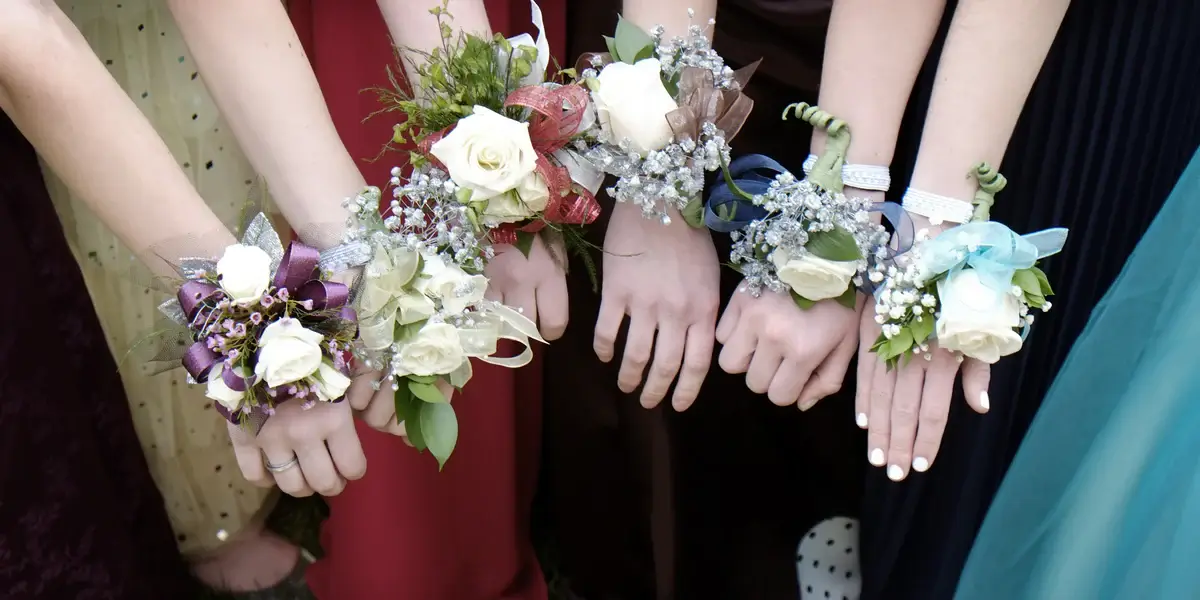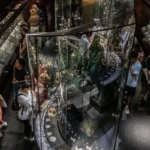A corsage is a petite flower arrangement that people use as accessories for special events. Like sophisticated adornments, corsages are elegant accessories that wedding guests normally attach either to their lapels or wristbands for formal events. Corsages serve as classic floral decorations respected in all wedding ceremonies, prom events, and Mother’s Day festivities to enhance event beauty. Portions of flowers organized into corsages retain their value through symbolic meaning and historical significance as people utilize them to create refined sentimental details in their special life events.
A Journey Through the History of Corsages
From the 16th century forward, corsages evolved as people began to employ flowers to communicate their social class and transmit specific messages. Prehistoric civilizations used flowers to create symbolic messages that convey love, purity, or honour.
Victorian lovers exchanged personal corsage gifts, which often combined powerful scented flowers with heart-shaped placements. Over time, corsages’ popularity increased alongside proms and wedding ceremonies, and they became customary at parties as a gesture to welcome guests, bride’s maids, and milestone figures at celebrations.
Since flowers carry significant symbolic meanings, corsages developed as a method of sharing emotions through the choice of flowers, whether to express love or admiration or celebrate occasions. Corsages remain a commonly used symbol for emotional communication, which people select to match their intended feelings.
Types of Corsages and Their Variations
Corsages come in various styles, each suited for different occasions and preferences:
Wrist Corsages:
Wrist bracelets function as stylish corsages that people can enjoy and carry easily. They are best at proms and weddings, and soft ribbons, beads, and lace enhance their bulk floral arrangement.
Pinned Corsages:
Clothing enthusiasts pin these corsages directly to shoulders, collars, or neckline areas. Pinned corsages remain a formal event classic that provides diverse floral arrangements for weddings and galas.
Boutonnieres:
Boutonnieres serve the same corsage function, though they exist technically outside that traditional classification. Men wear this tiny flower piece on their suit lapels, which functions as an accessory alongside women’s corsages at wedding ceremonies and proms.
Flower Choices and Their Meanings
When picking flowers for a corsage, people select beyond appearance since the chosen flowers represent personal sentiments through symbolic meanings.
Roses:
The quintessential symbol of love and romance. Weddings, anniversaries, and romantic prom celebrations benefit tremendously from these arrangements.
Orchids:
Orchids remain a magnificent choice for special formal events because they represent sophistication, stamina, and elegant refinement.
Carnations:
Mother’s Day corsages get their perfect fit from these lovely blossoms, representing long-lasting romantic love.
Lilies:
The elegant flower lilies, which appear in wedding celebrations and formal events, represent purity, beauty, and high elegance.
Non-Traditional Choices:
Traditional flowers remain classics, yet contemporary corsages contain succulents, berries, or silk flowers to create distinctive and resilient designs.
When to Wear a Corsage?
Corsages are associated with a variety of special occasions, each calling for a specific type of corsage:
Weddings:
Corsages have become standard at weddings, with the bride, bridesmaids, and mothers of the bride and groom typically wearing them. Bridal party members use wrist corsages to enhance their outfits and add special charm to wedding celebrations.
Proms and Formal Events:
A wrist corsage is the standard prom decoration choice since its design is based on the dress colour and style. The practice is an enduring tradition that expresses authentic happiness about celebrating events.
Other Special Occasions:
Corsages are traditional flower arrangements for Mother’s Day celebrations, graduation ceremonies, and special anniversary milestones. Flowers used in corsages typically represent one of three aspects: love and romance, grand celebrations, or family bonding events.
How to Choose the Perfect Corsage?
When selecting a corsage, consider these essential factors to ensure it complements both the wearer and the occasion:
Outfit Coordination:
When planning a corsage, flowers need to relate to the surrounding clothing or match it. Successful corsage coordination involves matching the dress colour with the bouquet or selecting complementary accents that complement the outfit.
Flower Preferences:
Before picking flowers, find out the recipient’s preferences and allergy information. Using their preferred flower type and colour within the corsage, the wearer’s style is reflected in the final creation.
Event Theme:
Your corsage selection heavily depends on the theme or formality level of the event you attend. Traditional flowers work best in classical wedding events, yet bold and bright flowers suit vibrant proms.
| # | Store Name | Location | Specialty |
|---|---|---|---|
| 1 | The Bougainvillea | Online (US & International) | Luxury floral arrangements for weddings & special events |
| 2 | ProFlowers | Online (US) | Fresh flower corsages for all occasions |
| 3 | 1-800-Flowers | Online (US & International) | Customizable corsages with a variety of floral options |
| 4 | Floom | Online (US, UK, and Europe) | High-end boutique florists for custom corsages and bouquets |
| 5 | Etsy | Online (Worldwide) | Handmade, custom corsages, including dried flowers & unique designs |
| 6 | The Flower Stand | New York City, NY, USA | Trendy and artistic floral designs, including corsages |
| 7 | Flowerama | Local (US, primarily in Ohio) | Affordable fresh floral corsages and bouquets |
| 8 | Lulu’s Flowers | Online (US) | Custom corsages, ideal for weddings and special events |
| 9 | FloraQueen | Online (Worldwide) | International flower delivery service with corsage options |
DIY Corsage: A Step-by-Step Guide
Handmade corsages offer a fulfilment path because they grant you complete control over arrangement structure and design elements. Here’s how to make your own:
Materials Needed:
- Fresh or silk flowers of your choice
- Floral wire and tape
- A ribbon or bracelet band for wrist corsages
- You can use both Corsage pins and a pin to attach the corsage
Step-by-Step Instructions:
Prepare the Flowers: First, cut off the stems and then remove every leaf that will block the way.
Create the Base: Wrap stem bundles in floral wire to form a wrist corsage. Pair the flowers however you want to build your pinned corsage.
Add Details: You should add ribbons and beads or ornamental elements to wrap around your bouquet flowers.
Secure the Corsage: Floral tape and ribbon work together to maintain proper alignment of your layout. When making wrist corsages, fit floral blooms onto ready-made wristbands.
Corsage Trends
While traditional corsages remain popular, contemporary designs are giving corsages a fresh, modern twist:
Minimalist Designs:
The stylish single-flower corsage is an elegant choice for minimalistic looks, balancing simplicity and subtlety.
Eco-Friendly and Alternative Materials:
Some people use dried or preserved flowers because they have longer lifespans and unusual visual appeal. The trend transforms corsages into wearable fashion designs through jewellery-based floral interpretations or decorative brooch forms.
Caring for Your Corsage
To make the most of your corsage, here are some care tips:
- Before the Event: Costs must remain cold and out of sunlight. You can keep flower corsages fresh by giving them a light mist with water.
- During the Event: Avoid applying pressure to your corsage because doing so may cause damage or destruction. A pinned corsage needs to have proper attachment security to avoid damage.
- Post-Event Care: After your event, you can choose two options for your corsage: drying or pressing the flowers, followed by storage in a shadow box or keeping it as memorabilia.
Conclusion
Throughout history, corsages emerged as vital celebration elements because they convey emotions while honouring special moments and enhancing dress appearance through their beauty. Passing along a corsage you’ve purchased from a florist or made yourself enriches special celebrations for you or someone else. When you plan your next special event, go ahead and follow this time-honoured custom. You can design a unique corsage while holding special meaning, ensuring everyone remembers it.
FAQ’s
1. What is a corsage?
Special moments benefit from the symbolism expressed through decorative little flower bouquets that people attach to their clothing or wrists during celebrations of love and honour.
2. What should I select when deciding on a wedding corsage?
Your corsage selection should align with your outfit and the theme of the day. When selecting your corsage, choose flowers that correspond to your wedding colours or hold significant personal value.
3. Can I make my corsage?
Yes! You need fresh or silk flowers and floral wire with a ribbon to craft a DIY corsagey easily. Adding a custom touch to your accessory is one exceptional result of this fitting process.
4. How do corsages differ from boutonnieres?
The classic wedding accessory of a corsage is worn on women’s wrists or as a wrist pin to their garments, and the boutonniere offers men the opportunity to decorate their lapels with tiny flower arrangements.
5. How long will a corsage last?
When properly cared for, fresh corsages can maintain their freshness for several hours up to a day, depending on flower selection. Flower life duration may be extended by proper hydration and cool-temperature storage until the event begins.
More to Read: Lgaming Awards






